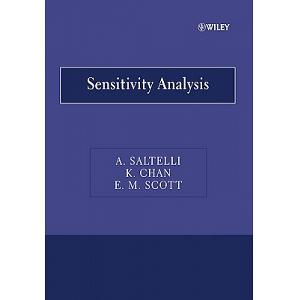Sensitivity analysis – examines how sensitive a particular NPV calculation is to changes in underlying assumptions. Sensitivity analysis is also known as what – if analysis and BOP (Best, Optimistic and Pessimistic) analysis.
Example – Solar Electronics Corporation (SEC) has recently developed a solar – powered jet engine and wants to go ahead with full- scale production. The initial (year 1) investment is $ 1,500 million, followed by production and sales over the next five years. The preliminary cash flow projection appears in table 1.
Table 1 – Cash flow forecasts for Solar Electronics Corporation’s jet engine
| year 1 | years 2 - 6 | |
| Revenues | $ 6.000 | |
| Variable costs | 3.000 | |
| Fixed costs | 1.791 | |
| Depreciation | 300 | |
| pretax profit | 909 | |
| tax (tc = 0.34) | 309 | |
| Net profit | 600 | |
| cash flow | 900 | |
| initial investment costs | $ 1.500 |
Should SEC go ahead with investment in and production of jet engine, the NPV at a discount rate of 15 percent is (in millions):
NPV = -$ 1,500 + 
= - $ 1,500 + $900 x 
= $ 1,517
Because the NPV is positive, basic financial theory implies that SEC should accept the project. However, is this all there is to say about the venture? Before actual funding, we ought to check out the project’s underlying assumptions about revenues and cost.
Revenues – let’s assume that the marketing department has projected annual sales to be:
Number of jet engines sold per year = market share x size of jet engine market per year
3,000 = 0,30 x 10,000
Annual sales revenues = number of jet engines sold x price per engine
$ 6,000 = 3,000 x $ 2 million
Thus, it turns out that the revenue estimated depend on three assumptions:
· Market share
· Size of jet engine market
· Price per engine
Cost – Financial analyst frequently divide costs into two types : variable cost and fixed cost. Variable cost change as the output changes, and they are zero when production is zero. Cost of direct labor and raw materials are usually variable. It is common to assume that a variable cost is constant per unit of output, implying that total variable costs are proportional to the level of production. Example – if direct labor is variable and one unit of final output requires $10 of direct labor, then 100 units of final output should require $ 1000 of direct labor. Fixed costs are usually measured as cost per unit of time, such as rent per month or salaries per year. Naturally, fixed costs are not fixed forever, they are fixed only over a predetermined time period.
Table 2 – different estimates for solar electronics’ solar plane engine
| variable | pessimistic | expected or best | optimistic |
| Market size (per year) | 5000 | 10000 | 20000 |
| Market share | 20% | 30% | 50% |
| Price | $ 1,9 million | $ 2 million | $ 2,2 million |
| Variable cost (per plane) | $ 1,2 million | $ 1 million | $ 0,8 million |
| Fixed cost (per year) | $ 1,891 million | $ 1,791 million | $ 1,741 million |
| Investment | $ 1,900 million | $ 1,500 million | $ 1,000 million |
The engineering department has estimated variable costs to be $ 1 million per engine. Fixed cost are $ 1,791 million per year. The cost breakdowns are:
Variable cost per year = variable cost per unit x number of jet engine sold per year
$ 3,000 million = $ 1 million x 3000
Total cost before taxes per year = variable cost per year + fixed cost per year
$ 4,791 million = $ 3,000 million + $ 1,791 million
These estimates for market size, market share, price, variable cost, and fixed cost as well as the estimate of initial investment. Table 2 represent the firm’s expectations or best estimates of the different parameters. For comparison, the firm’s analyst also prepared both optimistic and pessimistic forecasts for each of the different variables.
Standard sensitivity analysis calls for an NPV calculation for all three possibilities of a single variable, along with the expected forecast for all other variables. This procedure is illustrated in Table 3.
Table 3 – NPV calculations for Solar Plane Engine Using Sensitivity Analysis.
| variable | pessimistic | expected or best | optimistic |
| Market size (per year) | - $ 1,802 | $1,5717 | $ 8,154 |
| Market share | -696 | $1,5717 | 5,942 |
| Price | 853 | $1,5717 | 2,844 |
| Variable cost (per plane) | 189 | $1,5727 | 2,844 |
| Fixed cost (per year) | 1,295 | $1,5727 | 1,628 |
| Investment | 1,208 | $1,5727 | 1,903 |
Under sensitivity analysis, one input is varied while all other inputs are assumed to meet their expectation. For example, an NPV of - $ 1,802 occurs when the pessimistic forecast of 5,000 is used for market size. While all other variable are set at their expected forecast from table 2.
Table 3 can be used for a number of purposes. First, taken as a whole, the table can indicate whether NPV analysis should be trusted. Managers viewing the table will likely consider NPV analysis to be useful for the solar – powered jet engine.
Second, sensitivity analysis shows where more information is needed. Example – an error in the estimate of investment appears to be relatively unimportant because even under the pessimistic scenario, the NPVof $1,208 million is still highly positive. By contrast, the pessimistic forecast for market share leads to a negative NPV of - $696 million, and a pessimistic forecast for market size leads to a negative NPV of - $1,802. Because the effect of incorrect revenues is so much greater than the effect of incorrect estimates costs, more information about the factors determining revenues might be needed. Because of these advantages, sensitivity analysis is widely used in practice.
Unfortunately, sensitivity analysis also suffer from some drawbacks. Example – sensitivity analysis may unwitting increase the false sense of security among managers. Suppose all pessimistic forecasts yield positive NPVs, A manager might feel that there is no way the project can lose money.
Manager frequently perform scenario analysis, a variant of sensitivity analysis, to minimize this problem. Example, consider the effect of a few airlines crashes. These crashes are likely to reduce flying in total, thereby limiting the demand for any new engines. Furthermore, even if the crashes do not involve solar – powered aircraft, the public could become more averse to any innovative and controversial technologies. A series of scenarios like this might illuminate issues concerning the project better than the standard application of sensitivity analysis would.
Source: Corporate Finance Book, Stephen A.Ross, Randolph W.Westerfield and Jeffrey Jaffe, Ninth Edition.


No comments:
Post a Comment